How To Wash Your Face Properly
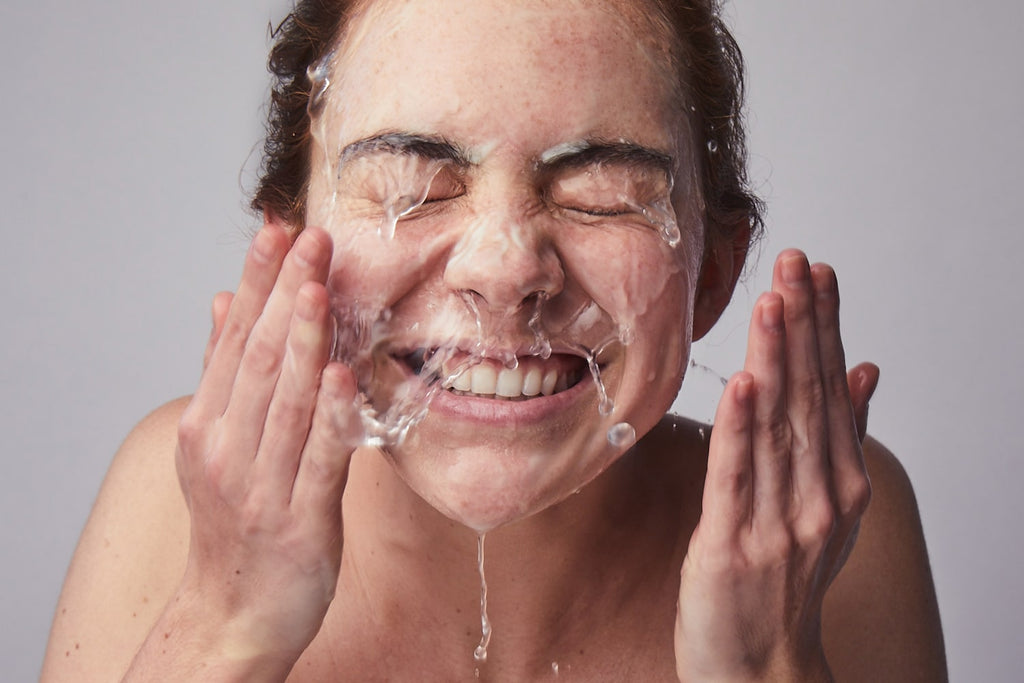
The act of washing your face seems pretty simple and straightforward, right? As it turns out, this task isn’t as mindless as most people tend to believe, and requires more effort than splashing some water on your face and slathering on a cleanser.
According to the American Academy of Dermatology, how you wash your face makes a difference. Even if you’re diligently washing your face twice a day, doing so in the wrong way might contribute to issues your trying to fix. Improper facial washing can result in dryness, oiliness, irritation, and even breakouts. Here we break down the steps for how to wash your face the right way as well as some face washing tips based on each skin type.
Using Your Face Cleanser Properly
For the best skin care routine, follow these steps to wash your face:
Step 1: Wash Your Hands
Contrary to popular myths, the safest way to wash your face is with your hands; washcloths and scrubs can be too abrasive on the skin, and might potentially harm healthy cells, resulting in irritation. It’s therefore essential to wash your hands before washing your face. If you wash your face with unclean hands, you can end up just pushing that dirt onto your face.
Step 2: Remove All Makeup
Even if your cleanser claims to also serve as a makeup remover, it’s a good idea to put an effort into taking off your makeup before washing your face. Doing so will be gentler on your delicate lashes, and by removing the extra layer of makeup, your cleanser will be much more effective at targeting the oil, dirt, and bacteria lingering on your skin. If you don’t remove your makeup first, your face wash might just be cleaning the superficial layer of your skin instead of diving deeply into the pores.
Step 3: Wet Your Skin Using Lukewarm Water
Hot water might feel nice, but it’s not doing your skin any favors. Hot water is dehydrating, as it will pull the moisture out of your skin and strip it of its natural oils. Keep the temperature a little lower – it’s enough to loosen up the dirt within your pores without outwardly stripping them. When learning how to wash your face, using lukewarm water is a big takeaway.
Step 4: Massage Cleanser into Skin
When washing your face, don’t just scrub vigorously for 20 seconds. It’s not only harmful to the skin’s surface, but it also doesn’t give your cleanser enough time to work its magic. Instead, massage your cleanser into your skin using gentle, circular motions for a minimum of 60 seconds. Doing so will stimulate the lymphatic system, which encourages oxygen and blood circulation. Be sure to move in upward motions – pulling down on your skin can lead to sagging.
Our vegan face wash, Cleanse is designed for all skin types and is formulated with detoxifying green tea, calming chamomile, and cooling cucumber. Gentle, yet effective, it removes any impurities without drying out the skin.
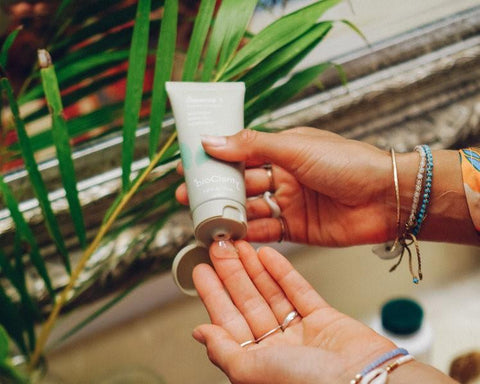
Step 5. Pat Dry
The skin on your face is delicate so exercise caution whenever anything comes into contact with it. Once you're done cleansing, gently pat your face dry with a soft towel after rinsing off your cleanser with lukewarm water. Make sure you’re using a fresh, clean towel each time you wash your face. The towels you use to dry off your hair and body could have pore-clogging residue on them left over from the shower, which could then spread germs and bacteria onto your freshly-washed face.
Face Washing Mistakes to Avoid
In addition to the five steps to wash your face, follow these face washing tips to ensure you’re following the best skin care practices:
Not Cleansing Twice a Day
Some people believe that washing your face in the morning is unnecessary, as it should still be clean from its wash the night prior. However, your skin attempts to regenerate itself overnight, meaning it's shedding dead skin cells, producing sebum, and secreting toxins as you sleep. Your pillowcase may also be riddled with built-up oil and bacteria from previous nights. Be sure to wash your face in the morning to get the most out of your day-time products if you have acne-prone skin.
Keep in mind that not every skin type benefits from being cleansed twice a day. If you have dry or sensitive skin, washing more than once daily may actually dry out your skin and cause irritation.
Using Harsh Chemicals
Regardless of what skin type you have, it’s always best to avoid harsh chemicals. Ingredients such as sulfates and alcohol might end up dehydrating your skin. This can result is roughness or flaking, or alternatively, excessive oil and breakouts by kicking the skin’s sebaceous glands into overdrive.
Neglecting Your Neck and Hands
The hands and neck are the first places to age on women, mostly because they are neglected when washing your face. This skin is sensitive and needs some love, too. Include these locations in every part of your skincare routine, beginning with cleansing.
Forgetting to Moisturize Afterwards
Hot water and strong chemicals will dehydrate your face, so it’s critical to moisturize after each cleanse. Keeping your skin cells moist is an essential part of maintaining its suppleness and plasticity throughout the day, in addition to maintaining its youthful glow and preventing premature aging. Apply a moisturizer directly after your face wash to seal in the face’s moisture to ensure your skin cells are strong enough to brave the day.
We recommend bioClarity's Hydrate: A skin smoothie for your face. This lightweight, breathable moisturizer is perfect for oily to normal skin and is packed with botanicals and good-for-you ingredients.
How Often Should You Wash Your Face?
There are a number of variables that impact how often you should wash your face, such as skin type, sensitivity, and your work and exercise schedule.
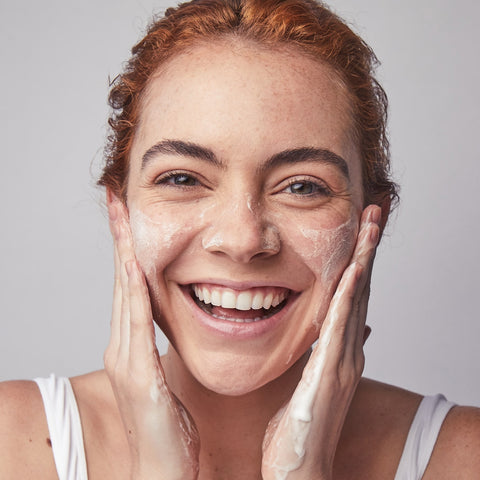
While you can identify your skin type and use that as a guideline for face washing frequency, you still need to pay close attention to when your skin becomes irritated from excessive washing. Symptoms to look out for include:
- Redness or irritation
- Itching, peeling, or flaking
- Areas of brittle, dry, cracking skin
- Unusual oil production
No two skin types are the same, and how much sebum (the oil secreted by the sebaceous glands in your pores) you produce will play a crucial role in your skincare regimen.
Oily Skin
You should especially wash your face twice daily if you suffer from excessively oily skin. Oil is prone to getting trapped in your pores which leads to blemishes, so be sure cleanse regularly to prevent breakouts.
Dry Skin
If you have a dry skin type, how many times a day you should wash your face will be less than those with oily skin. Avoid excessive cleansing which could strip your skin of its sparse, essential sebum. See how your skin reacts with washing twice a day and consider shifting to once a day if your skin becomes irritated, overly dry, or itchy. Also be sure to incorporate a heavier moisturizer if you're experiencing dryness.
Go Naked with Barefaced
This non-foaming jelly cleanser gently exfoliates and deeply cleans while clearing and purifying pores.
Shop BarefacedCombination Skin
When you have a combination skin type, where certain areas of your face are oily while others are dry, how often you should wash your face will vary. Generally speaking, you should wash your face twice a day—when you wake up and when you go to bed. However, this isn’t always the case; pay attention to your skin’s needs and watch how it responds to your routine. The best thing to do is wash target areas that you know are overproducing sebum or have frequent breakouts and spend less time on the clear skin areas.
Skin care products are typically labeled "for dry skin" or "for oily skin," making combination skin types especially tricky to shop for. Here are the different approaches you can take:
Single Product: Using a single product that has gentle ingredients which can be used all over your combination skin is one approach. While you won’t irritate the dry areas of skin on your face, you may not treat the oily areas as well as necessary.
Multi-product Routine: Sometimes the best approach is to use a set of products that target the different areas of the skin. Use astringents for the oily areas and moisturizing creams for the dry regions of your skin.
Ultimately, the best approach to take for finding the right products for your face is to purchase the ones that have the most natural ingredients and won’t irritate your skin. bioClarity offers gentle, effective skincare options that will provide your skin with the nourishment it needs to stay healthy and protected.
Should I Wash My Face in the Morning or Night?
If you have oily skin, you should wash your face once in the morning and once at night. However, if you have a normal or dry skin type, you might need to adjust that number, unless you can find a cleanser tailored to your unique complexion.
But what if you lead a busy lifestyle, and don’t have time for both a morning and nighttime regimen? If you have to settle on washing your face just once per day, the jury is still out regarding what time is most effective. In most cases, it’s better to wash at night to cleanse yourself of the dirt accumulated throughout the day, however, some skincare professionals insist on washing in the morning to remove the dead cells shed overnight.
Ultimately, the best time to wash your face is when you’ll actually do it, so try to incorporate your cleansing into the daily routines you already have in place.
Your Lifestyle Plays a Key Role
The final consideration in answering how often you should wash your face is your lifestyle. If you exercise frequently, be sure to do a quick cleanse after your workouts to prevent sweat from clogging your pores. Don’t avoid exercising out of fear of sports-related acne; the increased blood flow from an elevated heart rate actually helps improve your complexion by pumping oxygen to your skin—just remember to wash the grime and sweat off afterwards.
If you follow these simple steps and face washing tips, you’ll surely set yourself up for skincare success and be one step closer to healthy, youthful glow.
Keep It Clean
This effective yet gentle, foaming facial cleanser helps wash away makeup, dirt, oil, and environmental pollutants to leave your skin soft and smooth.
Shop Cleanse
Abby Vinas
Abby Vinas has long been an active member of the holistic health community, advocating in favor of its benefits to both our physical and emotional well-being. Her commitment to leading a healthy lifestyle has made her an authority on self-care practices. Abby is passionate about fitness, nutrition, and proper skincare, and is also an avid lover of avocado toast and dog-petting.
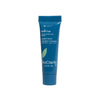
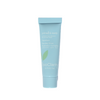
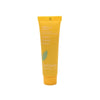
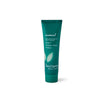










When it comes to moisturizing, I’m always confused. I suffer from acne (worse now as an adult than as a teen), and so I’m mostly using the clear skin regimen from Bio Clarity. Is this enough moisturizing? If I were to moisturize directly after cleansing, would that not impede the clear skin step 2 bottle which includes that sweet, sweet salicylic acid?
How should an acne prone person handle moisturizing in a way that will help their skin as opposed to clogging it up even more?
Thank you for the info! I’ve been using my body towel to dry my face, I will switch and hope that makes a difference!
I’ve been using the BioClarity Clear Skin Rountine plus Hydrate for two months now and af first, my skin got really nice & clear. But now, my ache is returning. The first few weeks I was in NYC where my skin always seems to overs up some and I’ve started to attribute to the water. I live in California and the water where I live is heavily chlorinated. Are there any tips on if this can be a factor to Ache, & what to do if that’s the case? Water filter on my bathroom sink?
Also, what about SPF protection? And is BioClarity going to offer an SPF moisturizer at any point?
Thanks!
Is it necessary to use a toner after cleansing?
This was very helpful, I just love all the advice you guys give. And I’m loving my bio- clarity products.